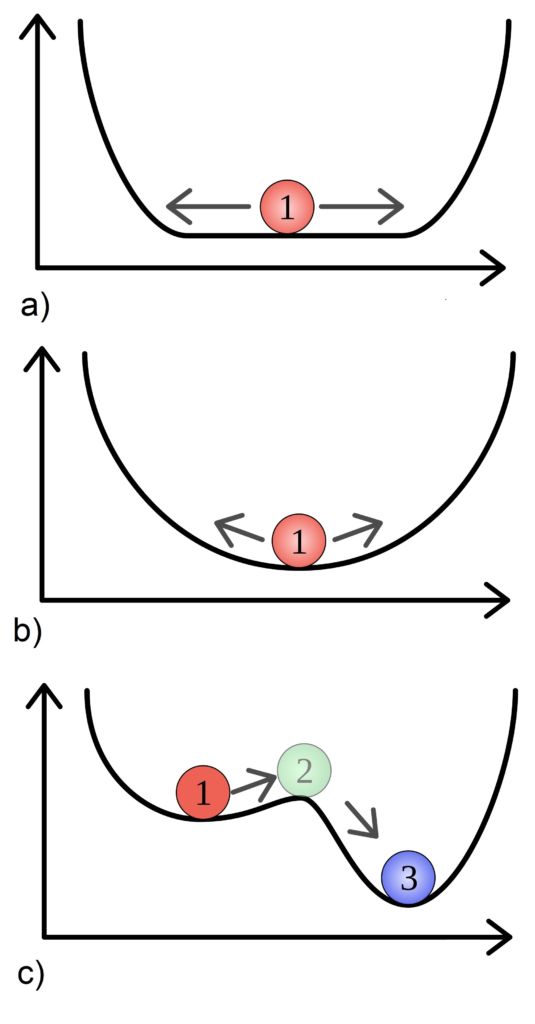Synergetics: The Agile Organisation
This episode of the synergetics series focuses on how the generic principles of self-organisation facilitate transformation processes.
“Grant me the serenity to accept potential wells, whose control parameters I cannot change,
–Serenity Prayer in Synergetics parlance
the courage to constructively shape those potential wells, whose control parameters I can influence,
and wisdom to know the difference.”
– when we understand which mechanisms and principles underpin transformation, we also begin to grasp what we can change and what not. Cultivating this sense is a key competence of good leadership in a VUCA world.


Source: © Georg Wiora, Wikipedia, CC BY-SA 3.0; adapted by me
As outlined in the previous episode, there are basically 2 forms of transition: Change & Transformation. The former relates to a pattern transition, thus an order transition within a certain potential landscape (cf. ball movements in Fig. 1). The latter refers to a change of the potential landscape itself through a change of a control parameter (cf. transformation from a to b in Fig. 1).
As a reminder: a potential well (2-dimensional) or the more complex potential landscape (more-dimensional) represents the scope of action of a particular system (human, organisation, etc.). Order parameters are the leading parts of the system (e.g. the organisational culture), which are comparatively easier to influence than the control parameters (e.g. the economic situation). The so-called “enslaved” parts are the relatively easiest to influence parts of the system, such as the organisation’s employees.
– Recap of the definitions of: potential well/ landscape, order & control parameters and enslaved parts of the system
Agility requires the acceptance of self-organisation
Healthy systems are characterised through their adaptive stability[1: p.28], as outlined in the previous episode. Adaptive stability can be illustrated by a diverse potential landscape (cf. c in Fig. 1), where order transitions from one well to the other are easily possible. Unhealthy systems are rigid, i.e. too stable – they cannot easily adapt to external changes. For example, if our mind-set is too fixed, we get stuck in behavioural patterns, which may be toxic for ourselves and/ or our environment (e.g. a toxic behaviour in relationships, psychological neuroses, depression, unmotivated employees).
In the context of organisations, we identify this adaptive stability – the fundamental prerequisite for a healthy and sustainable economic activity – as agility. Agile organisations do not deny that any complex system, such as social systems, are self-organised by nature. They are not at odds with the fact that a central control unit, or top-down delegate measures, are only beneficial to a limited extent and may not lead to the aspired outcomes, but may have unintended consequences instead. Agile organisations accept that self-organisation has always been playing a role on the backstage and welcome self-organisation on the front stage, to facilitate and cultivate it.
The generic principles of self-organisation
Therefore, a key-competence of good leadership in organisations is the facilitation of conditions, which allow self-organisation to unfold and promote transformation. It turns out, that leaders can utilize the principles of synergetics, and therefore of self-organisation, to facilitate such change- and transformation processes. For that purpose, Haken & Schiepek[1] derive the following generic principles. Generic is to be understood in terms of generating or producing.
Generic principles are conditions, “whose consideration for the facilitation and promotion of self-organised development processes seem to be essential.”
– [1: p.436; translated from German]
The 8 generic principles read as follows[1: pp.436-440 & 628-631]:
1. Facilitation of stability conditions:
Constructive change-/ transformation processes can only happen in the context of (not too rigid!) stability. At first glance, this sounds like a paradox. How can destabilisation (change/ transformation) happen within the context of stability? At second glance, however, this makes sense: Transformation processes require getting out of the comfort zone and this is promoted by the experience of some kind of (e.g. emotional, financial) backing. This principle, therefore, includes measures to ensure structural and emotional security, trust, promotion of self-confidence and the facilitation of conditions, which improve the autonomous motivation of employees. Transparency regarding the process of the transformation also adds positively to the experienced safeness of the participants (e.g. employees).

2. Identification of patterns in the relevant system:
What are the current order parameters of the system (including constraints) and its boundaries? What are the external influences? How does the informally evolved self-organisation of the organisation look like? What about the organisational culture? Is the purpose, which the organisation de facto lives, congruent with the purpose that is portrayed outwards and inwards? The identification of patterns, such as organisational purpose, “provides a reference system for the evaluation of changes/ transformations”[1: p.629].
3. Meaning:
A condition for a successful transformation process is the identification with one’s own life script. Only internal agreement with the values and the meaning of the transformation process sparks our autonomous motivation to participate. That is the reason why transparency (cf. Generic Principle 1) is so important, as well as to include the employees themselves in the process. In doing so, tribute is payed to the self-organised character of an organisation, in contrast to forcing top-down measures.
4. Identification of control parameters/ Enabling energy to flow:
What are the currently most dominating control parameters and constraints? In other words, what are the external influences? Is it the economic situation? The market situation? The customer satisfaction? Which control parameters are those that the organisation could influence and to which does it have to adapt? This principle is also about activating the resources available to the organisation, such as employee motivation, by enabling participation in the process and goal setting (cf. Generic Principle 3). Adaptation of the control parameters leads to a transformation of the potential landscape and therefore to dissolving deadlocked and unconstructive patterns.

5. Destabilisation/ Amplification of fluctuations & 7. Enabling deliberated symmetry breaking:
Transformation processes, i.e. potential landscape transitions, are naturally characterised by destabilisation. The intention is to “get the organisation off its balance of its prior comfortable processes”[1: p.630]. From comparing this with Generic Principle 1 follows, that self-organisation is fostered by a balance between the right mix of stability and instability. That is why in constructive transformation processes destabilisations don’t only happen within the context of some stability, but are also intentionally aimed at (as already announced in the previous episode). Thereby the system (i.e. organisation) is going through phases of instability. In these phases, the system is especially susceptible for inducing change, because minimal interventions can have a large impact (due to chaos theory). Given the nature of such chaotic process, the predictability of the exact consequences of these interventions is relatively limited. That is why agility needs leadership with a good and educated intuition.
6. Paying attention to “Kairos moments”/ Resonance/ Synchronisation:
Change/ transformation processes in complex systems, such as organisations, cannot just be “managed” from top-down. Instead, they depend on the parameters of the system, such as the organisational culture, the autonomous motivation of the employees and the market situation. That is why the timing and the coordination of procedures/ interventions are essential in transformation processes. Here again, good intuition in recognising “Kairos moments” is a prerequisite, because neither timing nor coordination are usually objectively measureable. Crucial is a willingness for transformation (cf. Generic Principle 3) and the synchronisation of dynamics, which constructively add to the transition process.
8. Re-Stabilisation:
The re-stabilisation of the newly emerged patterns during the process is an essential factor to determine the quality of the well-guided transformation process. It is immensely beneficial to the organisation’s adaptive stability that employees can identify with the new “order” – its (dynamics) structures, values, and boundary conditions (cf. Generic Principle 3).
Note: The generic principles of self-organisation do not only apply to large-scale transformation processes, but also to smaller-scale change processes, as well as during calmer, adaptively stable phases. The alignment of an organisation with the generic principles is an essential factor for fostering a sustainable and successful organisation, where employees enjoy their work (environment).
The blueprint of self-organisation …
… is like the pot of gold at the end of the rainbow.
– They do not exist.
The generic principles foster constructive self-organisation. However, given the chaotic nature of self-organisation, they are no template with guarantee of success, which one can just prescribe from top to down (of the list). They are to be considered simultaneously and in different phases of the transformation process different principles may be applied – in accordance with Generic Principle 6 of what fits best in the moment.
“The generic principles are to be understood as indicators and a basis of decision making for transformations and process control. […] However, no principles can be generally sufficient, because for interventions in complex, non-linear and partially intransparent systems there is fundamentally no guarantee for success.”
– [1: p.631; translated from German]
Therefore, looking for a blueprint, with which one can transform an organisation as quickly as possible from Old Work to New Work, from rigid to agile, is going to lead to disillusion. Not even respectable consultants can offer such a template and guaranteed success when it comes to a genuine transformation of an organisation (naturally, change process are more predictable). Just like a good psychotherapist, consultants and coaches can provide capacity building and a guidance for the organisation to activate their resources constructively. To this end, the Synergetic Navigation System (SNS) may be a handy tool, which enables an evidence-based approach to (self-)management – check out the next Blog article if that could be something for you!
References [1] Haken, H. & Schiepek, G. (2006, [2010]): “Synergetik in der Psychologie – Selbstorganisation verstehen und gestalten”, Hogrefe; Quotes are translated from German by me
Navigate through the episodes of the special theme The Science of Human Behaviour here:
Table of Contents
- Introduction to The Science of Human Behaviour
- Motivation: Research shows that there are 5 different types of motivation. Especially the aggregate forms – autonomous vs. controlled motivation – have a different impact on our well-being.
- Decision Making: Rational Choice Theory explains how we make our 35000 daily decisions and how social phenomena arise from our individual behaviour.
- Episode 1: From situation to action
- Episode 1.1: Institutional Norms
- Episode 2: Taking action
- Episode 2.1: Excursion: Deviant Behaviour
- Episode 3: Emergence of Social Phenomena
- Self-Organisation & Transformation: Synergetics – the meta-theory of order transitions – connects the natural sciences with the social sciences and explain what we can change and what we cannot.
- Synergetics-Dictionary
- Episode 1: Physical principles and basics
- Episode 2: The relevance of transformation
- Episode 3: The Agile Organisation
- Episode 3.1: The Synergetic Navigation System (SNS)
Written by Julia Heuritsch | Last edited: 2nd February 2023
This article was originally written for the blog of the unternehmensdemokraten.